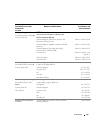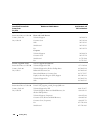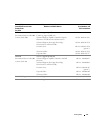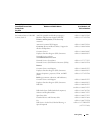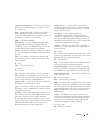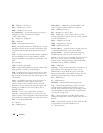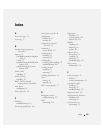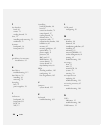
Glossary 157
expansion-card connector — A connector on the system
board or riser board for plugging in an expansion card.
F — Fahrenheit.
FAT — File allocation table. The file system structure
used by MS-DOS to organize and keep track of file
storage. The Microsoft
®
Windows
®
operating systems can
optionally use a FAT file system structure.
FBD — Fully buffered DIMM.
flash memory — A type of EEPROM chip that can be
reprogrammed from a utility on diskette while still
installed in a system; most EEPROM chips can only be
rewritten with special programming equipment.
format — To prepare a hard drive or diskette for storing
files. An unconditional format deletes all data stored on
the disk.
FSB — Front-side bus. The FSB is the data path and
physical interface between the processor and the main
memory (RAM).
ft — Feet.
FTP — File transfer protocol.
g — Gram(s).
G — Gravities.
Gb — Gigabit(s); 1024 megabits or 1,073,741,824 bits.
GB — Gigabyte(s); 1024 megabytes or 1,073,741,824
bytes. However, when referring to hard-drive capacity, the
term is usually rounded to 1,000,000,000 bytes.
graphics mode — A video mode that can be defined as x
horizontal by y vertical pixels by z colors.
group — As it relates to DMI, a group is a data structure
that defines common information, or attributes, about a
manageable component.
guarding — A type of data redundancy in which a set of
physical drives stores data and an additional drive stores
parity data. See also mirroring, striping, and RAID.
h — Hexadecimal. A base-16 numbering system, often
used in programming to identify addresses in the system’s
RAM and I/O memory addresses for devices. In text,
hexadecimal numbers are often followed by h.
headless system — A system or device that functions
without having a keyboard, mouse, or monitor attached.
Normally, headless systems are managed over a network
using an Internet browser.
host adapter — A host adapter implements
communication between the system’s bus and the
controller for a peripheral device. (Hard-drive controller
subsystems include integrated host adapter circuitry.) To
add a SCSI expansion bus to your system, you must install
or connect the appropriate host adapter.
hot plug — Describes the feature of the system that
enables you to swap a component of the system while the
system is running.
Hz — Hertz.
I/O — Input/output. A keyboard is an input device, and a
monitor is an output device. In general, I/O activity can be
differentiated from computational activity.
ID — Identification.
IDE — Integrated drive electronics. A standard interface
between the system board and storage devices.
integrated mirroring — Provides simultaneous physical
mirroring of two drives. Integrated mirroring functionality
is provided by the system’s hardware. See also mirroring.
internal processor cache — An instruction and data cache
built into the processor.
IP — Internet Protocol.
IPX — Internet package exchange.
IRQ — Interrupt request. A signal that data is about to be
sent to or received by a peripheral device travels by an IRQ
line to the processor. Each peripheral connection must be
assigned an IRQ number. Two devices can share the same
IRQ assignment, but you cannot operate both devices
simultaneously.
jumper — Small blocks on a circuit board with two or
more pins emerging from them. Plastic plugs containing a
wire fit down over the pins. The wire connects the pins
and creates a circuit, providing a simple and reversible
method of changing the circuitry in a board.
K — Kilo-; 1000.
Kb — Kilobit(s); 1024 bits.



